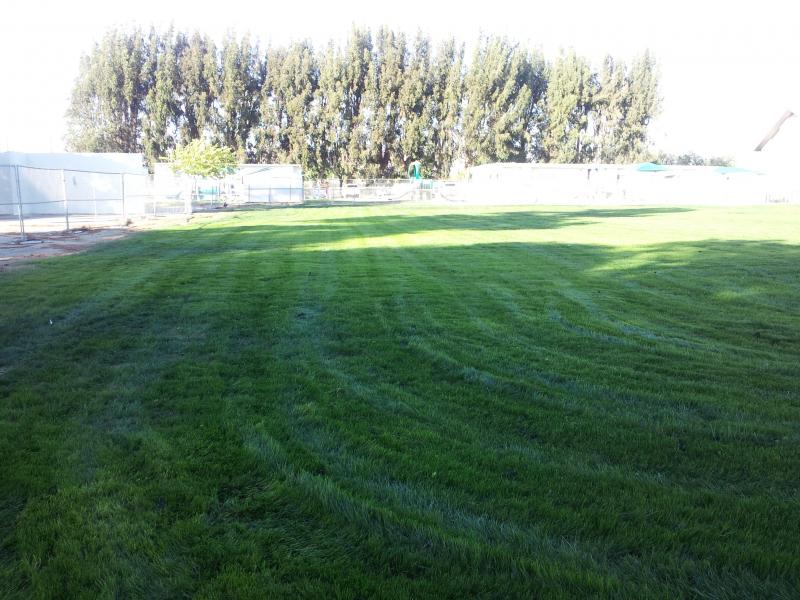Superior Hydroseeding, Inc.
Superior Hydroseeding, Inc.
ph: (831)763-1811
Turf Hydroseeding
Golf Courses, Sports Fields, Commercial Complexes, Private Landscapes -- from 1,000 SQFT to 1,000 Acres we have the equipment and personnel to seed your grass. We purchase all types of turf seed per project, so all seed has guaranteed purity and germination percentages and is the exact species and variety of your choice or specification.

Turf Type Tall Fescue
Is a cool season grass that forms a
dense turf when planted properly.
It grows in shade or sun and
withstands the abuse of high
traffic.
Dwarf Turf Type Tall Fescue
The characteristics of Dwarf
Fescue are: finer leaf texture, dark
green color and improved turf
density. Due to the slower
(vertical) growth habits of Dwarf
Turf Type Tall Fescue, fewer
mowings are required than other
tall fescues.
Fine Fescue
There are many types of
non-native and native fine
fescues. These grasses are great
for hard to mow slopes or areas
where low maintenance is desired.
These grasses can be mowed 2x
annually or less. Regular irrigation,
over seeding and weed pulling a
few times per year will provide a
kept, natural look.
Turf Type Perennial Ryegrass
Perennial Ryegrass is often
selected for its ability to germinate
and establish quickly. Its fine
blades and dark green color make
it a good choice for high quality
turf needs especially when kept at
low mowing heights
Kentucky Bluegrass - Common & Improved
Bluegrass has long been a
component in turf applications
due to its adaptability and
blue-green color. Common
varieties have a more upright
growth habit, fine to medium leaf
texture and medium green color.
Improved varieties have the ability
to form a tight turf by spreading
of tillers and rhizomes. Leaf width,
texture and color vary by variety
and are usually blended to
complement each other.
Kentucky Bluegrass requires more
maintenance than other turf
grasses but can mowed at a lower
height giving a distinct well
groomed appearance.
Some Things to Know About Hydroseeded Turf
As necessary, bring in a good quality top soil and or rototill amendments into the areas you plan to seed. Use caution when considering the addition of recycled wood compost. This material can contain weed seed which you do not want to introduce to your site. Also, recycled wood compost will take up nitrogen necessary for good germination of new seedlings. If soil fertility is in question, a soils test ($100 +/-) can simply determine what amendments should be added to your soil or to the hydroseed slurry to optimize turf growth. If a good turf stand (or weed stand) has flourished in the soil previously, a soils test is probably not warranted.
Proper irrigation is important. The irrigation system should have total coverage and should water evenly. Check for head-to-head coverage (overlap), low and high spots. Re-grade any deficiencies and adjust heads/change nozzles. The system should be capable of watering 2-5 times per day during the germination period.
Weed control is important. Remove undesired vegetation from the area. Water & fertilize the area to germinate weed seed. This will also show you if you have head-to-head coverage, or not. Dry areas will not grow grass. After weeds have germinated (7-14 days), spray the weeds with a contact weed killer like Round-Up, or remove the weeds by hand. Pre-seed irrigation and weed kill/removal may take more than one cycle depending on your site.
After hydroseeding, all surface areas must be kept continually moist with frequent light watering. Water 2-5 times per day depending upon
weather. Avoid puddling or runoff. Do not allow germinating seedlings to dry out or they will die. Once seed has germinated, and growth is established, water should be applied with less frequency, but for longer periods of time. Deep watering will establish deep root growth. Mow grass every 7-10 days depending on the species you have selected and fertilize with any balanced fertilizer 1-3 times per year depending upon species and soil conditions. Regular mowing will manage weeds and push lateral growth, creating a tight stand of grass.
C27 & C61/D59 License 683292
DIR No. 1000009317
CDOT SWBE & DBE Firm No. 7183
Copyright 2020 Superior Hydroseeding, Inc.. All rights reserved.
Superior Hydroseeding, Inc.
ph: (831)763-1811
